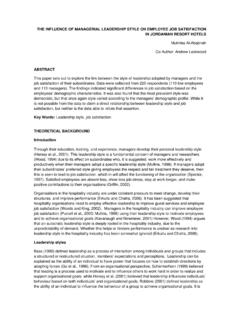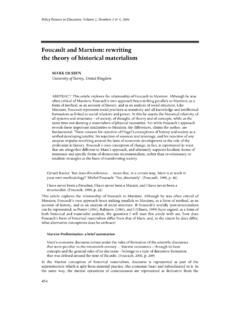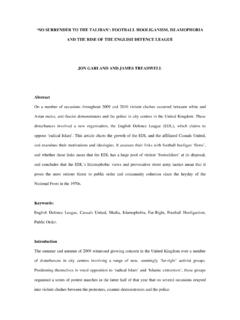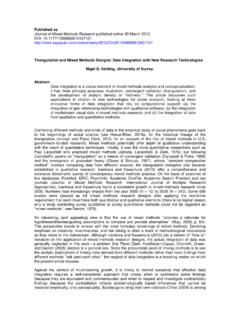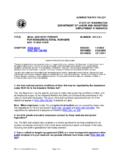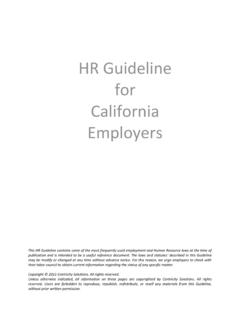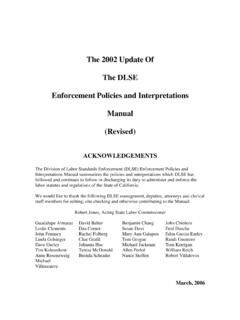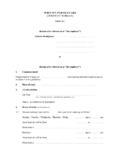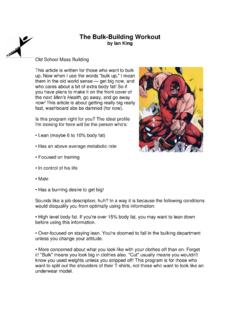Transcription of Flight- Catering - University of Surrey
1 Jones, P. (2007) flight - Catering , in Becker, H. And Grothues, U. (2006) Catering -Management Portrait einer Wachstumsbranche in Theorie und Praxis, Behr sVerlag: Hamburg Chpt , p. 39-55 flight - Catering Introduction The flight Catering industry is a very large, global activity. The total market size is estimated to be around 12 billion euros. More than 1 billion passengers are served each year. It is probably one of the most complex operational systems in the world. For instance, a large-scale flight Catering production unit may employ over 800 staff to produce as many as 25,000 meals per day during peak periods. Large international airlines may have more than 1,000 takeoffs and landings every day. A single, long-haul Boeing 747 has over 40,000 items loaded on to it before it flies. All together these items weigh 6 metric tonnes and occupy a space of 60 cubic metres. These items range from meals to toilet bags, from duty-free goods to first aid boxes, from newspapers to headsets.
2 Food items must be fresh and items for personal passenger use must be clean and serviceable. These facts and others like them make flight Catering unlike any other sector of the Catering industry. While the way food is served on trays to airline passengers bears some resemblance to service styles in restaurants or cafeterias, the way food is prepared and cooked is increasingly resembling a food manufacturing plant. Certainly the hot kitchen in a typical production kitchen is often no more than 10% of the total floor area. The rest of the space is used for bonded stores, tray and trolley assembly, and flight wash-up. And almost certainly there are far more loaders and drivers employed than chefs. The way food and equipment is stored resembles a freight warehouse, and the way meals and equipment are transported and supplied has a close affinity to military-style logistics and distribution systems.
3 When the very large numbers and variety of items which must be loaded for passenger service during a flight are considered, together with the need for them to be loaded at widespread locations, the logistics complexity is obvious. It is therefore not surprising that the President of KLM Catering once said that flight Catering is 70 per cent logistics and 30 per cent cooking. Role of Food Onboard How important are food and onboard service to the airlines? Some airlines use food as a marketing tool. A number of airlines advertise their product by making food the focal point. But food as a marketing tool has only a limited impact. Surveys over a number of years suggest that passengers appear most concerned about safety, on-time performance, scheduling/ticketing issues, the aircraft's physical surroundings such as seat and leg comfort, and gate check-in and boarding. This means that while food is important, it is unlikely to be the deciding factor in a passenger's airline choice.
4 This is most clearly seen in the USA where deregulation has had a great effect upon competition and fare wars are common. This has led to most US airlines implementing a no-frills policy where no meals are served on board flights within the USA. This same trend is evident in Europe, with carriers such as Ryanair and EasyJet offering low cost, no frills flights between European destinations. Consumer (and media) perceptions of meal quality in airlines is low. This may be due to a number of factors which affect passengers appetite and behaviour whilst flying. Sensory abilities such as smell, sight, and taste are affected by the relatively low humidity and air pressure experienced at altitude. This affects taste buds (which may function as much as 30 percent below par) and mucous membranes in the nose (which blunts the sense of smell). Airline food is often more highly seasoned for these reasons.
5 Likewise, at such a high altitude not all wines retain their subtle aroma and bouquet and this has to be taken into account when wine lists are chosen by the airlines and caterers. Also, as passenger movement and exercise is limited at such high altitude, the meals provided need to be easily digestible. Moreover, the effects of alcohol are more quickly observed in a pressurised cabin and on dehydrated passengers Research at the University of Surrey suggests that while food and drink in flight may not affect pre-purchase decisions, it emerges as a highly significant post-purchase factor. The onboard service and meal is the most remembered aspect of people s travel experience, so the food service offered to passengers is still an important part of the overall service experience but as the factors listed above begin to suggest, providing a product that will satisfy the customer is about much more than simply providing a ready meal.
6 The passenger receives a final product that can consists not only of well-seasoned food but one that is made up of many different products procured from many different places and through many different processes. Major Stakeholders The in- flight Catering industry consists of five major players: the airlines, or their various representatives; the providers, in this case specialised flight caterers; the suppliers, either to the providers or direct to the airlines; those using the airline's services, that is the fare-paying passengers and distributors (Fig. ). Figure Major Stakeholders in flight Catering PassengersAirlinesProviders (Caterers) Suppliers (Food) (Non-food) Distributor a) Role of the passenger A feature of the airline industry is the huge diversity of customers. Prior to the 1960s, air travel was exclusive only the very rich or government employees would fly long haul. The development of jet aircraft and charter airlines lead to mass air travel.
7 Subsequently in the 1990s, the business model was redesigned by the operators of so called low cost or budget airlines. b) Role of airlines Airlines are responsible for the design of onboard service. This is affected by the time of flight , length of flight , point of embarkation and disembarkation, nationality or ethnicity of passengers, seat class (economy, business or first), budget allowed by the airline, price of food, seasonality of food, cost of labour to make a food item, time required to serve the food, number of flight attendants available to serve food, time needed to consume food, ability of meal to be consumed in a small place on a plane, the time and effort needed to clear an item, the needs and desires of the passengers, odours that may penetrate the cabin, the ability of meal to be rethermalised and the ability of the meal to withstand low humidity and pressures. Given this long list of variables it is not surprising that the nature of onboard service varies widely from flight to flight and airline to airline.
8 C) Role of caterers Caterers have two main roles: to prepare items not bought in directly from suppliers to a state ready for loading on board and to assemble trays and trolleys. flight kitchens are always located near to major airports and are usually used to 'manufacture' consumable food items. There are two main reasons why menu items may be made outside of airport-based flight kitchens: the cost of space and the cost of labour. Airport space is at a premium so often it is not feasible for a flight kitchen to produce all of the meals needed for every seat class. For instance, some flight kitchens or caterers may make their first-class, and in some cases business-class, meals from scratch at the flight kitchen and outsource all other meal production. The caterer is often in an unusual and sometimes difficult, position. Although they are a customer of the supplier, the products used may not be of their choosing but may have been determined by the airline.
9 When the products used are those purchased directly by the airline, caterers only charge for a handling and storage fee of the product but not the cost of the product. For instance, all liquor products for tax reasons must be purchased by the airlines, either through a prepaid arrangement with the distributor or through an arrangement whereby the charges are directly invoiced to the airline. However, the caterer is often responsible for keeping and accounting for any such products and these products are usually delivered directly to the caterer s bonded store. The challenge for caterers is that the products are the property of the individual airlines served by the caterer. Products belonging to one airline cannot be used for another, even if the two airlines use identical products. d) Role of suppliers Suppliers may supply the inflight industry in two main ways.
10 First, based on the planned menus, the supplier receives direct orders from the airlines, although they deliver their goods to flight kitchens operated by the contracted caterers. Airlines buy direct from suppliers because they want to have continuity of supply in all their stations, because they negotiate a discount, or because they want to maintain a particular brand image. Second, the supplier may supply the caterer directly, with products that meet the contract specification. Likewise suppliers have two approaches to manufacturing their products. Some supply airlines (or their caterers) with their standard products, whereas others make and supply specialist products specifically designed for the in- flight kitchen. In the first instance, the manufacture of these products is likely to take place in a factory or plant producing many other products. The products for in- flight service may be slightly modified for that market.
